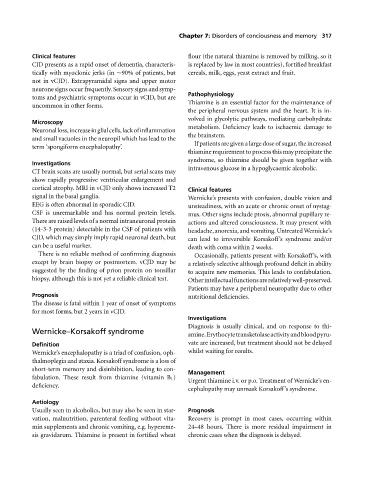Page 321 - Medicine and Surgery
P. 321
P1: FAW
BLUK007-07 BLUK007-Kendall May 25, 2005 18:18 Char Count= 0
Chapter 7: Disorders of conciousness and memory 317
Clinical features flour (the natural thiamine is removed by milling, so it
CJD presents as a rapid onset of dementia, characteris- is replaced by law in most countries), fortified breakfast
tically with myoclonic jerks (in ∼90% of patients, but cereals, milk, eggs, yeast extract and fruit.
not in vCJD). Extrapyramidal signs and upper motor
neurone signs occur frequently. Sensory signs and symp-
Pathophysiology
toms and psychiatric symptoms occur in vCJD, but are
Thiamine is an essential factor for the maintenance of
uncommon in other forms.
the peripheral nervous system and the heart. It is in-
volved in glycolytic pathways, mediating carbohydrate
Microscopy
metabolism. Deficiency leads to ischaemic damage to
Neuronalloss,increaseinglialcells,lackofinflammation
the brainstem.
and small vacuoles in the neuropil which has lead to the
If patients are given a large dose of sugar, the increased
term ‘spongiform encephalopathy’.
thiamine requirement to process this may precipitate the
syndrome, so thiamine should be given together with
Investigations
intravenous glucose in a hypoglycaemic alcoholic.
CT brain scans are usually normal, but serial scans may
show rapidly progressive ventricular enlargement and
cortical atrophy. MRI in vCJD only shows increased T2 Clinical features
signal in the basal ganglia. Wernicke’s presents with confusion, double vision and
EEG is often abnormal in sporadic CJD. unsteadiness, with an acute or chronic onset of nystag-
CSF is unremarkable and has normal protein levels. mus. Other signs include ptosis, abnormal pupillary re-
There are raised levels of a normal intraneuronal protein actions and altered consciousness. It may present with
(14-3-3 protein) detectable in the CSF of patients with headache, anorexia, and vomiting. Untreated Wernicke’s
CJD, which may simply imply rapid neuronal death, but can lead to irreversible Korsakoff’s syndrome and/or
can be a useful marker. death with coma within 2 weeks.
There is no reliable method of confirming diagnosis Occasionally, patients present with Korsakoff’s, with
except by brain biopsy or postmortem. vCJD may be arelatively selective although profound deficit in ability
suggested by the finding of prion protein on tonsillar to acquire new memories. This leads to confabulation.
biopsy, although this is not yet a reliable clinical test. Otherintellectualfunctionsarerelativelywell-preserved.
Patients may have a peripheral neuropathy due to other
Prognosis nutritional deficiencies.
The disease is fatal within 1 year of onset of symptoms
for most forms, but 2 years in vCJD.
Investigations
Diagnosis is usually clinical, and on response to thi-
Wernicke–Korsakoff syndrome
amine.Erythocytetransketolaseactivityandbloodpyru-
Definition vate are increased, but treatment should not be delayed
Wernicke’s encephalopathy is a triad of confusion, oph- whilst waiting for results.
thalmoplegia and ataxia. Korsakoff syndrome is a loss of
short-term memory and disinhibition, leading to con-
Management
fabulation. These result from thiamine (vitamin B 1 )
Urgent thiamine i.v. or p.o. Treatment of Wernicke’s en-
deficiency.
cephalopathy may unmask Korsakoff’s syndrome.
Aetiology
Usually seen in alcoholics, but may also be seen in star- Prognosis
vation, malnutrition, parenteral feeding without vita- Recovery is prompt in most cases, occurring within
min supplements and chronic vomiting, e.g. hypereme- 24–48 hours. There is more residual impairment in
sis gravidarum. Thiamine is present in fortified wheat chronic cases when the diagnosis is delayed.

